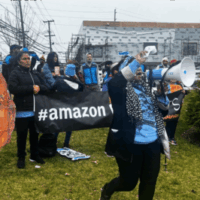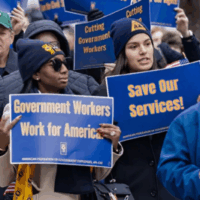Remembering Those Killed on the Job 47 Years After OSHA Opened Its Doors
This Workers’ Memorial Day, as we honor workers who have tragically lost their lives on the job, we must also confront the brutal truth that their deaths were preventable.
Nearly 5,200 workers were killed on the job last year. That is 14 workers a day who sacrificed their lives for a paycheck. Meanwhile, more than three million more suffered a serious work-related injury.
Most of us have no idea so many workers are killed or injured on the job each year. Very few of these tragedies garner media coverage, though the impact of every death and serious injury has an enormous impact on the worker’s family and community.
The reality is that most of these tragedies would not have happened if employers had followed common-sense safety rules. Yet the Trump administration has rolled back the safety protections that ensure workers are as safe as possible. Far from keeping his promise to stand with America’s worker, the president has sided with wealthy corporations, letting them dictate the rules of the game.
The men and women who lost their lives on the job last year went to work in the morning and never came home. They worked at all kinds of jobs—from construction, to manufacturing, to health care. They were killed by breathing in the chemicals they used on the job, by oil explosions, by falling from roofs and through skylights when no fall protection was provided, and from being stabbed by a resident at an assisted-living facility.
Most employers try to do the right thing when it comes to worker safety—but some cut corners. That’s why 47 years ago, on April 28, 1971, with bipartisan support, the Occupational Safety and Health Administration opened its doors. Since OSHA was created, the number of work-related fatalities and serious injuries in the U.S. has dropped dramatically, even with a workforce that is now twice as large.
Simply put, OSHA saves lives. Mostly importantly, when employers follow OSHA safety rules, injuries are prevented and lives are saved, allowing workers to come home whole so they can continue to spend time with their families and participate in their communities. Employers also save billions of dollars because they are not paying for medical costs, down time for incident investigations, costs of training and hiring new workers, and more.
Yet, through the decades, wealthy corporations with a swarm of lobbyists have tried to shut the agency down. They pedal the myth that we must choose between ensuring that workers are safe and creating jobs—but there are no facts to support that false narrative. The facts are clear: OSHA doesn’t kill jobs—it prevents jobs from killing workers.
Sadly, the corporate lobbying groups have an impact. As it is, OSHA is so small that it would take the agency more than 150 years to visit every workplace under its jurisdiction just one time. In contrast, a typical local health department pays a visit to every restaurant under its purview each year.
In its tenure, the Trump administration has consistently bowed to industry pressure and has further weakened the agency. The chances of an OSHA inspector visiting a workplace has grown even more remote. To illustrate their lack of concern with the vital work that OSHA does, the administration did not fill any inspector vacancies in the agency for an entire year—driving the number of OSHA inspectors down to the lowest numbers since the George W. Bush administration.
To the Trump administration, protecting workers is clearly not a priority—and these policy decisions have real, human ramifications. For example, in some states, like Mississippi—which has a very high rate of workplace fatalities—the number of inspections has dropped precipitously.
Along with its Congressional allies, this administration also repealed a new safety rule that required companies to keep accurate injury records, as well as another rule that would have held large government contractors accountable for obeying safety and labor laws. Additionally, the Trump administration’s USDA has proposed allowing hog slaughter plants—one of the most dangerous industries in the country—to increase factory line speeds, which would greatly endanger the safety of tens of thousands of workers and millions of consumers.
The list goes on. The administration has tried to get rid of a small grant program that educated workers in the most dangerous industries about how to protect themselves, and it has told industry supporters that they will propose a rule change to allow children to apply the most dangerous pesticides on farms and lawns. And in an unprecedented move, the administration proposed to strip away protections against cancer-causing beryllium from maritime and construction workers.
If you still think one year in a new presidential administration could not possibly make a difference in how OSHA conducts itself, consider this: The number of companies cited with major fines for safety violations has dropped by almost half since the President Trump took office.
In his inaugural address, Trump promised that every decision he made would be made to benefit America’s workers—but instead, this administration has significantly weakened workplace protections, putting millions of workers in danger.
Today, on Workers’ Memorial Day, we must first and foremost remember and honor all those killed and seriously injured on the job—but we must also fight to ensure that they did not die in vain.
Each life lost should serve as a clear reminder that enacting and maintaining strong worker protections and ensuring that we enforce the law should always be a top priority for our nation’s policymakers—and for all of us.
Related to
The Latest News
All newsMayor Bowser & D.C. Council Must Respect the Will of D.C. Voters by Rejecting Repeal of Initiative 82

Blog
New Brief Sheds Light on the Amazon’s Dangerous ‘Flex’ Labor Model

News Release
NELP Denounces Supreme Court Ruling Permitting Immediate Layoffs of Hundreds of Thousands of Federal Workers

News Release

